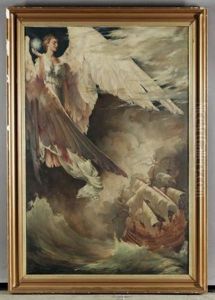Thomas Barrett Paintings
Thomas Barrett was an English artist known for his contributions to painting and printmaking during the early to mid-20th century. Born in 1902 in a small town in England, Barrett grew up in an era where the world was rapidly changing due to the aftermath of the Industrial Revolution and the beginning of modernism in art. Despite the lack of formal art education in his early years, Barrett displayed a keen interest in drawing and painting from a young age, which was encouraged by his family.
His artistic journey began in earnest when he moved to London in the 1920s to attend the Royal College of Art. Here, Barrett was exposed to a wide range of artistic movements, including Impressionism, Cubism, and Expressionism, which played a significant role in shaping his early artistic style. His work from this period demonstrates a fascination with the urban landscape of London and the daily lives of its inhabitants, captured through a blend of realism and abstraction.
As the 1930s progressed, Barrett's style evolved to include elements of Surrealism, reflecting the growing tension and uncertainty in Europe at the time. His paintings from this period often feature dream-like scenes with distorted figures and landscapes, revealing his concerns about the rise of fascism and the approach of World War II. Despite the political turmoil, Barrett continued to exhibit his work in London and even participated in several group exhibitions with other British Surrealists.
The outbreak of World War II had a profound impact on Barrett's life and work. He served in the British Army, and his experiences during the war deepened his exploration of themes related to human suffering, conflict, and the resilience of the human spirit. After the war, his work became more introspective, focusing on the emotional and psychological scars left by the conflict.
Thomas Barrett's career was tragically cut short when he died in 1947 at the age of 45. Despite his relatively brief career, Barrett left behind a significant body of work that continues to be celebrated for its emotional depth and technical skill. His paintings and prints are held in various public and private collections, and his contribution to British art of the 20th century remains recognized by art historians and critics alike.






